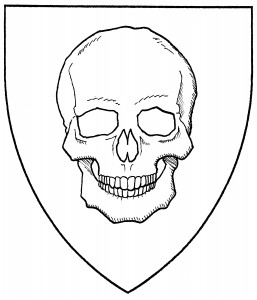A skull is the shell of bone found within a beast’s head; the default skull is a human skull, and is also called a “death’s head”, especially when drawn without the lower jaw. It’s found in the arms of Bolter, 1632 [Guillim2 161], but is more famous as the attributed arms of Death [Neubecker 222].
Period armory gives us a few examples of animal skulls, such as the “cow’s skull” in the canting arms of Capo di Vacca, c.1550 [BSB Cod.Icon 275:23]. Such animal skulls should have distinctive characteristics (e.g., horns) that permit them to be identified. Absent period evidence, they should not be depicted in profile.
Unique to Society armory is the “demon’s skull”, defined to be a human skull with horns (and optionally fangs); no difference is granted from a standard human skull.
All skulls are affronty (cabossed) by default. The field should not show through the eye and nasal cavities. For related charges, see head, skeleton.
Conrad Sturmere bears: Argent, three skulls sable.
Calam Stiùbhard bears: Per pale gules and argent, a death’s head counterchanged.
Bodo Rosti bears: Quarterly sable and gules, in bend sinister two jawless skulls argent.
Bjorn Rhys bears: Per bend sinister argent and sable, a stag’s skull caboshed sable.
Rhys ibn al-Makhdoom bears: Sable, a demon’s skull and on a chief argent three demon’s skulls gules.
